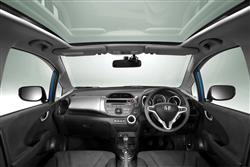This is a sample, showing 30 seconds of each section.
FREE FORM JAZZ (some text hidden) SECTIONED_new_hondajazz_140109
By Steve Walker
Introductionword count: 120
Honda is a car maker that never appears to waste much time looking at what its rivals are doing. It's a company with a well-developed picture of the way things should be done and rather than obsessing over the competition, it gets on with doing them. This approach has given rise to some apparently unusual cars over the years but the great thing about Hondas is that they invariably turn out to work and work well. The second generation Jazz isn't one of the quirkier Honda offerings but it does go about its business in a very different way to most other superminis of its era. Does that make it a used car to seek out or one to sidestep?
Modelsword count: 12
Models Covered: 5dr supermini (1.2, 1.4 petrol [S, SE, ES, EX, Si])
Historyword count: 206
The original Jazz was launched in 2001 and it laid the groundwork for the second generation car we're featuring here. It was tall, roomy and in many respects, felt more like a small MPV than a supermini. The range was limited and Honda steadfastly refused to fit a diesel engine despite other superminis with diesel power being offered in numerous trim levels and selling like cold beer on Bondi Beach. True to form, when the second generation Jazz turned up in 2008, Honda stuck to its guns. There was no diesel engine despite the market apparently crying out for one, the practical focus remained, largely at the expense of the sportiness which other brands were building into their small cars, and the range wasn't a big one. The car also continued where its predecessor left off by garnering widespread critical acclaim and a number of awards. 1.2 and 1.4 petrol engines were offered from the start with a trim level choice that ranged from S and SE to ES and EX. Few changes were made to the Jazz but in a bid to inject some extra sportiness into proceedings, an Si models was introduced early in 2010 with a body kit and various other styling accessories.
What You Getword count: 406
The packaging brilliance of the first generation Jazz was made possible because the designers moved the fuel tank from beneath the rear seats to a position under those at the front. This approach was continued with the Mk2 model and as before, it liberates the floor of the cabin and allows the seats to be folded into all sorts of permutations. Granted, you don't get the option of removing the rear seats but they almost make up for this in their sheer versatility. The car features the Honda Magic Seating system through which the back seats can fold down in one fluid motion into the footwell with the headrests in place. What's more impressive still is that this action doesn't involve scurrying around the car to manually slide the front seats forward, it can all be accomplished from the rear door thanks to a convenient set of levers. Sports fans will appreciate the fact that if you then recline the front passenger seats, there's enough room inside the diminutive Jazz for a pair of 240cm long downhill skis! Garden centre shoppers meanwhile, will love the way you can lift up the rear seat cushion against the rear seat back creating a tall protected space in the rear seat footwells for items like plants. Meanwhile, you can also load up the surprising spacious Double Trunk boot which can divide its 399-litre capacity into four different configurations for carrying different loads. Fold the rear seats and there's 883 litres of space. Instead of the sprawling line up of different engines and trim levels that are offered by rival manufacturers, Honda kept things relatively simple. The Jazz came in one five-door bodystyle and two mainstream petrol engines with a select group of trim options. Standard equipment includes a CD stereo with MP3 compatibility and speed-dependant volume control. Safety was a major focus in the design process of the Jazz. The car features Honda's ACE body structure which works to help avoid crash situations where larger vehicles ride up over smaller ones. A polygonal front frame channels impact forces back through the car to prevent damage to the passenger compartment. Standard safety equipment was very generous with dual front and side airbags plus full length curtain airbags on all models. There are also five three-point seatbelts with reminders for the belts in the front and the back. Honda's VSA stability control system was available as an option on all models.
To see the full road test text contact us on 0330 0020 227
Pictures (high res disabled)
.jpg)
.jpg)
|
.jpg)
|
.jpg)
| |||

|
.jpg)
|
Statistics (subset of data only)
Min |
Max |
|
Insurance group 1-50: |
13 |
17 |
CO2 (g/km): |
104 |
129 |
Max Speed (mph): |
113 |
|
0-62 mph (s): |
11.5 |
13.1 |
Urban Mpg: |
40.9 |
61.4 |
Extra Urban Mpg: |
57.7 |
64.2 |
Combined Mpg: |
50.4 |
62.8 |
Length (mm): |
3900 |
|
Width (mm): |
1695 |
|
... and 4 other stats available | ||
Scoring (subset of scores)
Category: Small Runabouts
| Performance | |
| Handling | |
| Comfort | |
| Space | |
| Styling, Build, Value, Equipment, Depreciation, Handling, Insurance and Total scores are available with our full data feed. | |



